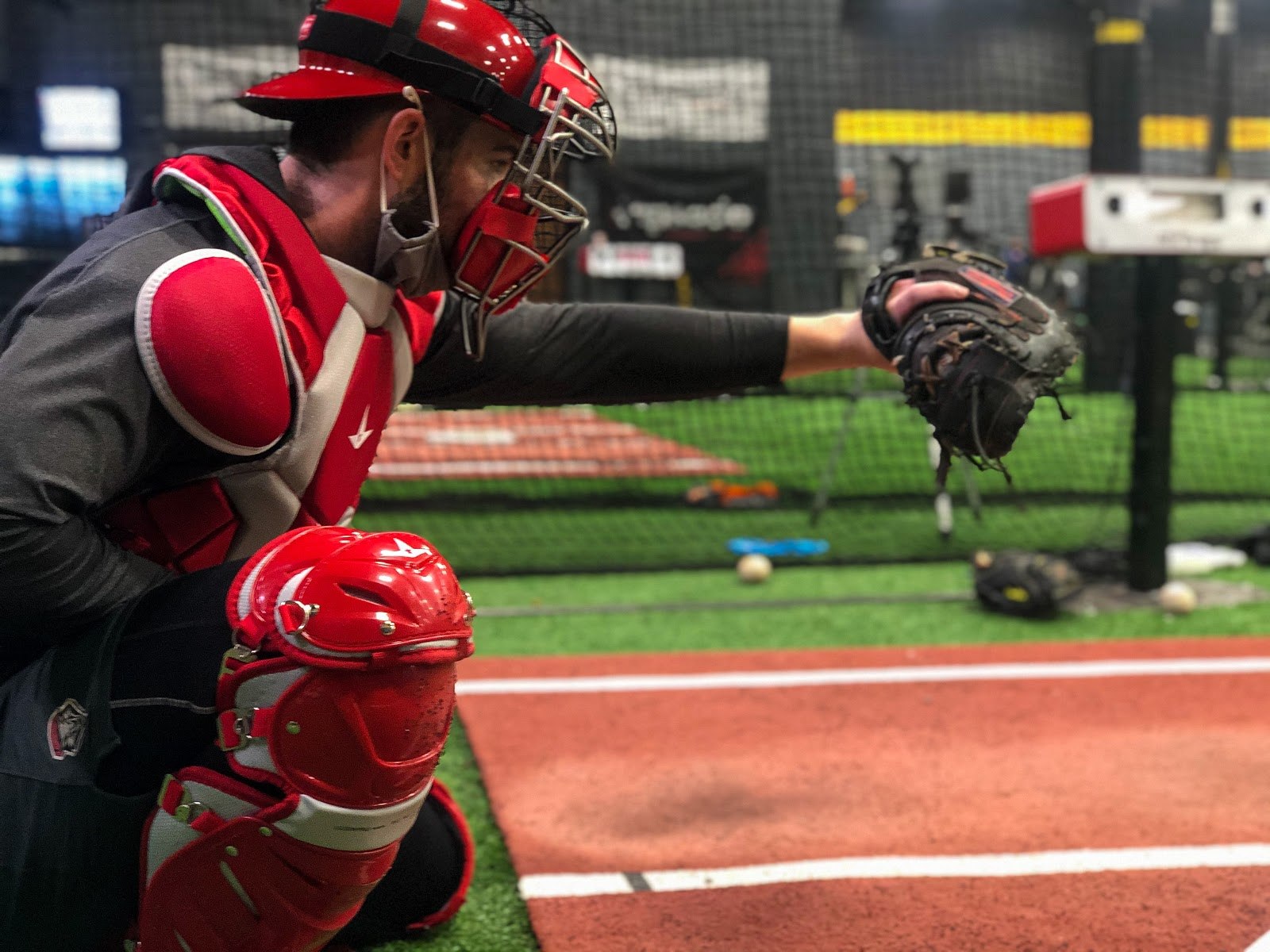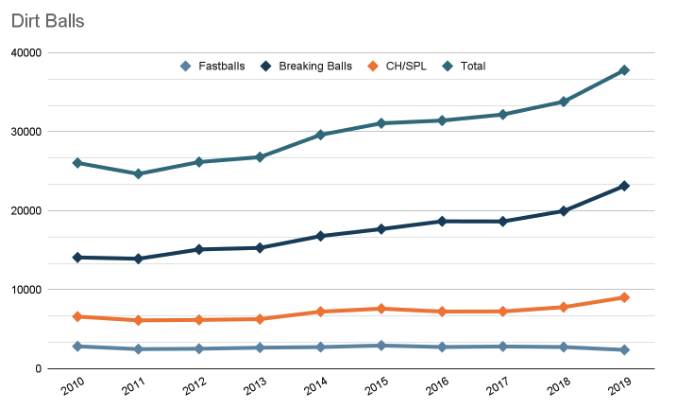Catching Drills for Development: Three Areas to Improve

Written by Maxx Garrett – Catching Coordinator & Hitting Trainer
Let’s talk about the catching position and some of our favorite catching drills to improve these key skills. To paraphrase our first catching blog, the three areas of catching we train at Driveline are:
- Receiving
- Blocking
- Throwing
This blog will dive into each of these skills and detail quantitatively why we train each one.
How are Catchers Valued?
Below is a graphic showing positional WAR (wins above replacement) adjustments for different positions on the field. The main takeaway here is that catchers provide more defensive value than any other position, and it’s not really close.
Due to a rise in the three true outcomes (strikeouts, walks, and home runs), defensive opportunities have been trending down since 2006. Fewer plays in the field mean more value is riding on the ball/strike outcomes of every pitch. Which skilled catchers can influence.
Let’s now take a look at the measurable skills that make up the position. In no particular order, catchers have to receive, block, throw, hit, and run the bases. Comparing how much value catchers can create across these skills, we can roughly prioritize how important each one is.
As might be expected, hitting is extremely important, however, looking at just the defensive components we see this distribution:
- 31.3% framing
- 11.5% blocking
- 3.0% throwing
Framing is by far the most important skill. This makes sense given the number of pitches a catcher receives every game. It is important to note that since we’re only looking at MLB catchers, so this analysis is a bit limited.
All MLB catchers can throw and block at a very high level, or else they wouldn’t be catching in the MLB. That results in some survivorship bias and could cause framing to take a bigger piece of the pie. At lower levels of baseball, where not every catcher is equally skilled at throwing and blocking, these percentages are likely closer in value.
We see great blockers get more playing time at lower levels and strong arms tend to stand out even more in amateur competitions, given the larger deviations in talent levels. If we want to separate ourselves as catchers we need to improve in all three of these areas. Let’s dive into ways we can create effective catching drills to work on these key skills.
Catching Drills for Receiving
Receiving: the setup of a catcher and the manner in which he catches the ball. If done correctly, a good receiver will increase the chance of a pitch being called a strike
In 2008 PITCHf/x’s tracking technology gave baseball the ability to precisely track pitch locations. We were then able to quantify the skill of framing and measure the impact it had on the game. Before PITCHf/x, catcher value could only be measured using stolen bases, caught stealing, wild pitches, passed balls, and errors. PITCHf/x opened the door for new analyses. Dan Turkenkopf sounded the alarm in 2008 when he wrote warily about the giant gap between first and worst pitch framers.
Mike Fast decided to take a look, and broke things loose in his study on the value of catcher framing where he found a 90-run difference between the best and worst teams behind the plate. Max Marchi and Ben Lindbergh built on this work and sparked a league-wide interest in catchers with good receiving skills.
- 10 runs ≈ 1 win
- Cost of acquiring 1 win in free agency = $8 million
- 90 runs ≈ 9 wins
- 9 wins ≈ $72 million
Starting catchers get around 6000 framing opportunities across a season. Turn balls into strikes on a nightly basis, and it becomes apparent how talented backstops can accumulate a lot of value with only their receiving skills. According to Baseball Prospectus, the differences in best and worst framers from 2016-2019 are as follows (minimum 5000 chances):
- 2021 – 25 runs
- 2019 – 40 runs
- 2018 – 33 runs
- 2017 – 50 runs
- 2016 – 45 runs
With all the attention given to receiving in the public analysis realm, it’s no surprise that the difference between the best, worst, and league average receivers has significantly tightened. The days of Jose Molina being +75 runs better than other catchers are in the past. Nonetheless, this likely reflects a higher floor for becoming a major league catcher.
The players and teams are aware of the numbers and have allocated training time and resources in an effort to get more calls.
Catching Drills for Blocking
Earlier we learned that blocking may not be as impactful as receiving. However, this does not mean blocking isn’t an important skill for catchers to develop. Pitchers are upping their breaking ball usage, and this has increased the number of pitches thrown in the dirt.

An increase in balls in the dirt means it’s important for catchers to train to handle them. If you want to play the position, you need to be able to block. If you want to stand out as a catcher, you need to block everything AND keep it close.
Blocking is really just an extension of receiving, and that’s how we treat it. Even at the big league level catchers have tailored their stances to help them either block or throw. Oftentimes, a catcher will excel in one area but struggle in the other.
Think of it this way, as a catcher you are always receiving the ball. When it’s close to the zone, you are receiving it and framing it. When it’s in the dirt, you are receiving it through a “pick” with the glove or receiving it with your body. With a runner on, you are receiving in a manner that optimizes for a quick transfer and firm throw.
At Driveline, we work with each catcher individually to find set-up positions that work for them.
Catching Drills for Throwing
While you may not often see it in the game, a strong arm is often a catalyst for advancement opportunities in baseball. Arm strength is weighed heavily in evaluations and will be a barrier to entry if it’s not up to par. Every throw from the catcher is evaluated, it’s important that the arm is fit for duty.
2019 – Velo: 78.4 Exchange: .72 Pop: 2.00
2018 – Velo: 79.6 Exchange: .73 Pop: 2.01
2017 – Velo: 79.7 Exchange: .73 Pop: 2.01
Baseball Savant – Velo is taken from throws on all steal attempts (2B & 3B)
Strong arms behind the plate help to throw runners out, but another very useful byproduct is deterring runners from trying to steal in the first place. Velocity from behind the plate cuts down the runner’s math equation: catcher’s throw + pitcher’s time to home.
Deterring Runners
A catcher’s ability to deter runners from stealing looks like it will be a more important metric in the future as the MLB trials new pickoff rules for pitchers. In Low-A, a pitcher is only allowed two step-offs or pickoffs per plate appearance. The new rules also require pitchers to actually step off the mound when picking off to a base. This step-off rule nixes two popular pickoff moves:
1. The “inside move” to second base where the pitcher picks up the lead leg like a normal delivery before turning towards second.
2. The lefty move to first base where the pitcher picks up his lead leg and either picks off to first, or throws home.
This “step-off” rule was implemented halfway through last year’s Atlantic League (independent league) season, and steal rates increased significantly from 1.03 to 1.69 attempts per game. Success rate of stolen bases subsequently jumped from 75% to 81%. If these rule changes make it to all the other levels of baseball, having a strong arm behind the plate will become even more of a necessity.
Pop time Floor
When it comes to catcher defense, we see that each competition level has a pop-time floor. If you can’t throw the ball down to 2B under a certain time, you will not be given opportunities to catch. This is why we train catcher arm strength and arm fitness. We want our athletes to meet and exceed these barriers to entry, as well as help them throw healthy and at a high level for the ENTIRE season.
Game Management & Final Thoughts
While these three categories count for the majority of the skill work that we spend time on at Driveline, we’d be very remiss if we didn’t address the last component of successful catching: game management.
While quantifying this aspect of catching can be a little more difficult, the importance of game calling, managing a staff, and getting the most from your teammates is still very real, and something coaches and scouts value and discuss. Catchers find themselves in a unique position: looking out at the defense, working with the pitcher, and directing the defense.
They are essentially an extension of the coaching staff, working with the pitcher and the defense to suggest and aid in-game plan execution. We can stress test these “intangibles” by training in a competitive environment. Live ABs and summer league games serve as stages where athletes can trial gameplans with the pitcher and the training staff, as well as develop their communication and leadership skills. These environments create opportunities to build on their experience calling games and working with different types of pitchers.
Driveline trains catchers to develop receiving, blocking, throwing, and game-management skills. If you train here, you’ll compete everyday as a hitter and defender, while also honing in on your pitch calling and game management skills. We are dedicated to helping you grown into the best catcher you can possibly be.
Train at Driveline
Ready to get to work? (In-gym and remote options are both available.)
- Athlete Questionnaire: Fill out with this link
- Email: [email protected]
- Phone: 425-523-4030
Comment section